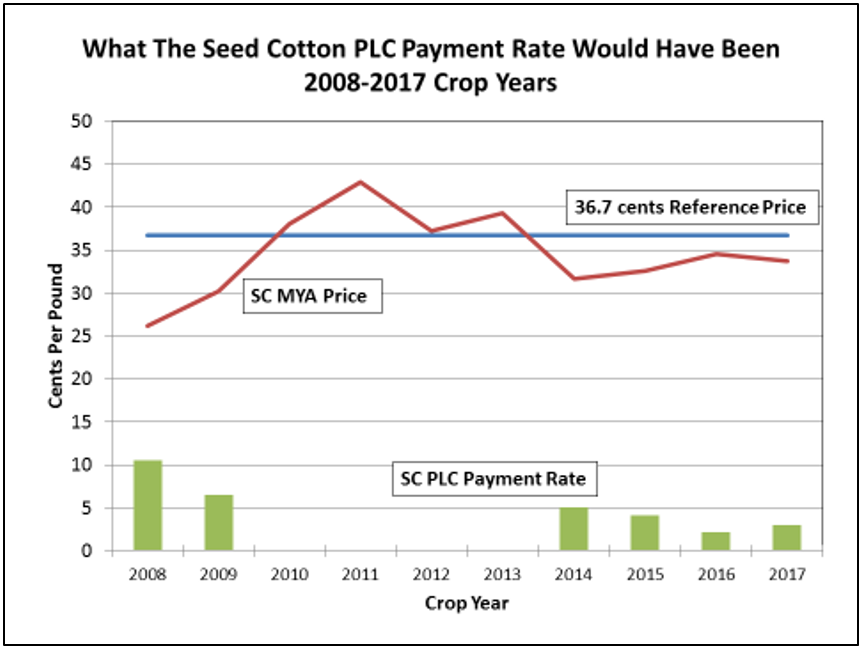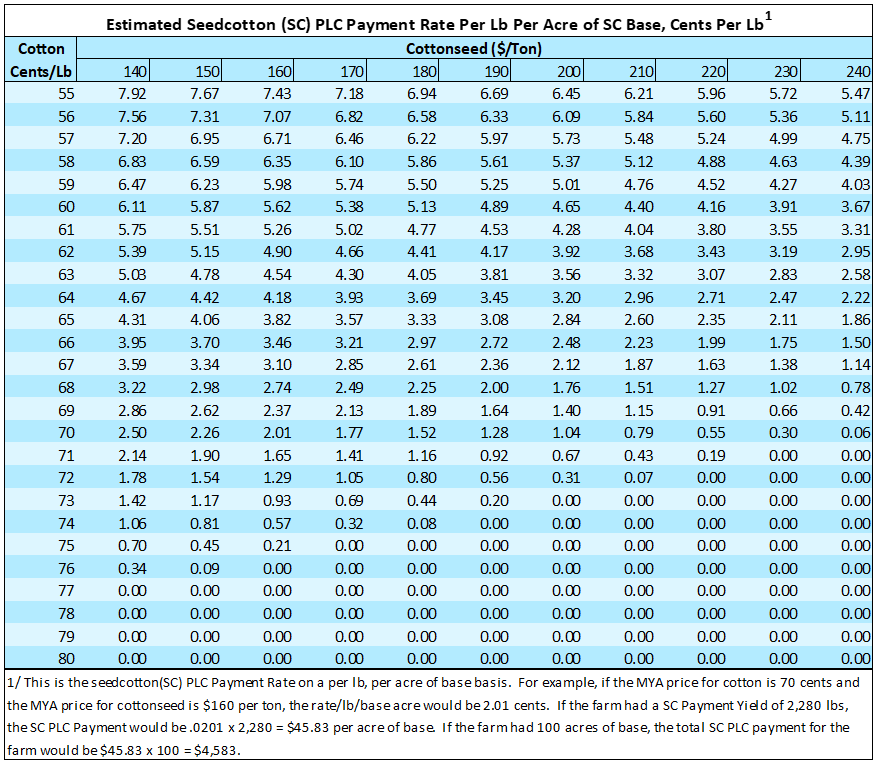Don Shurley and Adam Rabinowitz, Department of Agricultural and Applied Economics, University of Georgia
Effective with the 2018 crop, “seed cotton” is now a covered commodity under Title I of the 2014 farm bill and eligible for Price Loss Coverage (PLC) payments. For purposes of the legislation, “seed cotton” is unginned upland cotton—a combination of both cotton (lint) and cottonseed.
Seed cotton is eligible for both PLC and Agricultural Risk Coverage (ARC). This fact sheet discusses the PLC option only1. This fact sheet is the second in a series of publications that briefly explain the basic workings of this new seed cotton program2.
Reference Price and Payment
The Reference Price for seed cotton (SC) is 36.7 cents per lb. This is fixed in legislation and does not change. This is a weighted average “combo price” for lint and seed. A PLC payment is made if the weighted actual Market Year Average (MYA) price is less than 36.7 cents. The MYA “floor price” is 25 cents. This means if the MYA is less than 25 cents, 25 is used. This effectively caps the PLC payment rate at 11.7 cents.
If the SC MYA price is less than 36.7 cents, SC PLC Payment Rate = 36.7 – (higher of MYA price or 25 cents)
If the SC MYA price is greater than 36.7 cents, SC PLC Payment Rate = 0
MYA Price
The seed cotton (SC) MYA price is a weighted price based on upland cotton production and total (all) cottonseed production. USDA-NASS publishes these production numbers and MYA prices. The MYA price is calculated as follows:
Upland cotton production (lbs) = million bales x 480 lbs per bale
All cottonseed production (lbs) = million tons x 2,000
Total Pounds = upland cotton (lbs) + total cottonseed (lbs)
Seed cotton (SC) MYA Price = (upland cotton lbs/Total lbs) x upland cotton MYA price + (cottonseed lbs/Total Lbs) x cottonseed MYA price
As an example, let’s suppose US upland cotton production were 20 million bales and the MYA price for upland cotton was 70 cents/lb and let’s suppose total or all cottonseed production were 6.53 million tons and the MYA price was $180 per ton or 9 cents/lb:
Upland cotton production = 20 million bales x 480 lbs = 9,600 million or 9.6 billion lbs
All cottonseed production = 6.53 million tons x 2,000 = 13,060 million or 13.06 billion lbs
Total Production = 9.6 + 13.06 = 22.66 billion lbs
SC MYA Price = (9.6/22.66) x $0.70 + (13.06/22.66) x $0.09 = $0.349 or 34.9 cents/lb
If the MYA price is less than the 36.7 cents reference price, a PLC payments is made. Notice that since this is a “combo price”, the MYA will be impacted by what happens to both prices. A decrease in the MYA price for lint could be partially offset by an increase in the price of cottonseed and vice versa.
What to Expect
Let’s assume this seed cotton (SC) program had been in effect for the past 10 years (2008-2017 or since beginning of the 2008 farm bill). The table below shows what the MYA price for seed cotton (SC) would have been each year using the formulas just described. Upland cotton and cottonseed production for 2017 are the latest USDA projections. Upland cotton and cottonseed prices for 2017 are MYA estimates by the authors based on data to-date. For these 10 years, the SC MYA price averaged 34.63 cents per lb. The SC MYA price would have been below the SC PLC Reference Price 6 out of the 10 years. Over the 10 years, including zero years, the PLC payment rate would have averaged 3.15 cents/lb per year.
For these 10 years, the SC MYA price averaged 34.63 cents per lb. The SC MYA price would have been below the SC PLC Reference Price 6 out of the 10 years. Over the 10 years, including zero years, the PLC payment rate would have averaged 3.15 cents/lb per year.
Base Acres
This seed cotton program applies only to farms with Generic Base (former cotton base under the 2008 farm bill) and that have planted cotton or a covered commodity during 2009-2016. If a farm currently has no Generic Base, none is earned under this program. If a farm has Generic Base but has planted no cotton or covered commodity in 2009-2016, the Generic Base will become “unassigned” base and ineligible for ARC/PLC.
Any PLC payment will be made on seed cotton base acres. Landowners will be given several options to choose from to convert Generic Base to seed cotton base or base of seed cotton and other covered commodities like peanuts, corn, soybeans, wheat, etc. This will be based on the farms planting history from 2009-2012. This is the same window of history that was used in the “retain” or “reallocate” decision for the 2014 farm bill. Payments are made on base acres, not acres planted. There is no requirement to plant cotton or any other covered commodity to be eligible for a seed cotton payment. Payment, if any, is made on 85% of base acres.
Payment Yield
If a farm has Generic Base (former cotton base), that base also has a cotton CCP (countercyclical payment) yield already established for it under the 2008 farm bill. This was the yield used to make countercyclical payments under the 2008 farm bill.
For purposes of the seed cotton program, landowners will be given the option of keeping this current CCP yield or updating it to 90% of the average yield for 2008-2012. This is the same window of history that was given for covered commodities to update PLC payment yields for the 2014 farm bill.
The seed cotton payment yield will be the CCP yield times 2.4.
Payment Example
The following is a hypothetical example of how a seed cotton (SC) PLC payment would be calculated assuming a SC MYA price of 33.5 cents/lb.
Base Acres 87 acres
CCP Yield 900 lbs
Seed cotton payment yield 900 x 2.4 = 2,160 lbs
SC MYA Price 33.5 cents
SC PLC Payment Rate = 36.7 – 33.5 = 3.2 cents per lb
SC PLC Payment = $0.032 x 2,160 lbs x 87 acres x 85% = $5,111 for this farm (FSN)
Payment Per Acre of Base = $5,111 / 87 = $58.75
Payments Calculator
The seed cotton MYA price is a weighted price—as illustrated, dependent on upland cotton production and cottonseed production and the MYA price for both. It is a “combo price”. The following is a table of estimated SC PLC payments at varying combinations of lint price and cottonseed price. The table shows the seed cotton (SC) PLC Payment per lb of seedcotton payment yield per acre of base. This makes it easy and convenient for a producer to estimate what the SC PLC Payment would be for his/her specific situation.
Suppose the MYA price for cotton (lint) is 70 cents/lb and the MYA price for cotton seed is $180/ton or 9 cents/lb. From the table, the PLC payment rate per lb per acre would be 1.52 cents. Suppose the farm has 90 acres of seed cotton base and a seed cotton payment yield of 2,160 lbs:
SC PLC Payment = $0.0152 x 2,160 = $32.83 per acre of seed cotton base
Total SC PLC Payment = $32.83 x 90 acres of base = $2,955 for the farm (FSN)
Payment is received on only 85% of base acres but this has already been factored into the payments table. The payment rate of 1.52 cents allocated over all base acres would be equivalent to 1.79 cents received on 85% of base acres.
- There is an ARC option that can be chosen instead of PLC. ARC is revenue based depending on both yield and price. Because of relatively low prices, and in some cases county yields in recent years, ARC may not provide as much of a safety net asPLC.
- The first publication in this series is “The Bipartisan Budget Act of 2018: What Farmers and Landowners Need to Know About Cotton and Generic Base”, AGECON-18-02, Department of Agricultural and Applied Economics, University of Georgia
Acknowledgment
Appreciation is expressed to the Georgia Cotton Commission and the Georgia Peanut Commission for funding support. Appreciation is expressed to the National Cotton Council for review.
- November 2025 Weather Summary & Winter Outlook - December 5, 2025
- Friday Feature: The History of Beekeeping - December 5, 2025
- Friday Feature:Malone Pecan Festival Tractorcade - November 21, 2025
